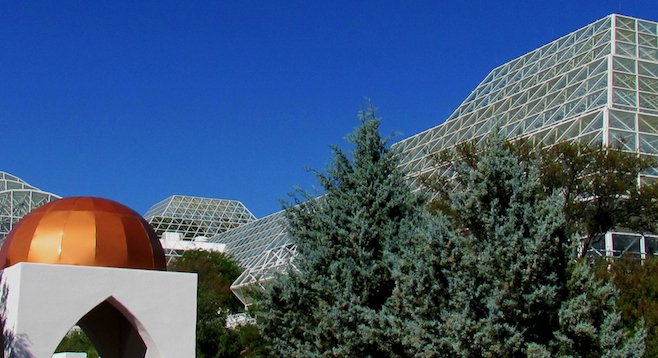 Facebook
Facebook
 X
X
 Instagram
Instagram
 TikTok
TikTok
 Youtube
Youtube

Between 1987 and 1994, the $200-million Biosphere 2 structure with its two “lungs” and Energy Center was constructed on 40 rolling meadow acres west of the Santa Catalina Mountains and a half-hour north of Tuscon, in the town of Oracle.
Glimmering in the Arizona sunshine, Biosphere 2 was built to accommodate closed life systems research relevant to space exploration. Not too far-flung a notion, given the fact that Russia had just completed 10 missions in the smaller Bios-3 and that NASA tears through an average of $15.8 billion annually.
The brainchild of systems ecologist and engineer J.P. Allen, Biosphere 2 encloses over three acres within a 91-foot steel-framed glass pyramid. The heavily instrumented laboratory is equipped with 2,000 electronic digital data collection stations situated throughout five recreated biomes – ocean, mangrove swamp, savannah, rainforest and coastal desert. The facility was initially stocked with over 3,000 species, including food sources intended to sustain the crew.
The highly publicized, privately funded Mission 1 locked a crew of eight scientists behind glass in 1991 where they, for the most part, remained for two years. (A crew member was released for an hour for emergency medical attention when she sliced off the top of her finger in a thresher.)
Discover magazine claimed that it was "the most exciting scientific project undertaken in the U.S. since President Kennedy launched us toward the Moon." And it was. But that didn’t deter naysayers from inflating the few unforeseen problems that arose.
When 1993 rolled around and the crew members were released, the media had deemed the experiment a failure due to a highly rare “El Nino” induced cloud cover that persisted for much of the second year, contributing towards increased carbon dioxide levels. Diminished oxygen left the crew lethargic and agitated while the high levels of CO2 killed off some of the crops.
As a scientific research experiment, it had always been assumed that the lessons learned from Mission 1 would be addressed in subsequent missions. However, there was never to be another completed mission. In March of 1994, Bass partnered with Columbia University to launch Mission 2, but by September the mission had been aborted due to a managerial dispute.
Since then, no closed life system research has been conducted at the facility that Time-Life Books recently identified as one of 50 must-sees in its Life Wonders of the World.
The University of Arizona now operates the facility as a global ecology laboratory focused on climate change research, and guided tours are conducted daily except Thanksgiving and Christmas. Because the cost of admission supports scientific academic research, half of the $20 tour fee qualifies as a tax-deductible charitable contribution.


Between 1987 and 1994, the $200-million Biosphere 2 structure with its two “lungs” and Energy Center was constructed on 40 rolling meadow acres west of the Santa Catalina Mountains and a half-hour north of Tuscon, in the town of Oracle.
Glimmering in the Arizona sunshine, Biosphere 2 was built to accommodate closed life systems research relevant to space exploration. Not too far-flung a notion, given the fact that Russia had just completed 10 missions in the smaller Bios-3 and that NASA tears through an average of $15.8 billion annually.
The brainchild of systems ecologist and engineer J.P. Allen, Biosphere 2 encloses over three acres within a 91-foot steel-framed glass pyramid. The heavily instrumented laboratory is equipped with 2,000 electronic digital data collection stations situated throughout five recreated biomes – ocean, mangrove swamp, savannah, rainforest and coastal desert. The facility was initially stocked with over 3,000 species, including food sources intended to sustain the crew.
The highly publicized, privately funded Mission 1 locked a crew of eight scientists behind glass in 1991 where they, for the most part, remained for two years. (A crew member was released for an hour for emergency medical attention when she sliced off the top of her finger in a thresher.)
Discover magazine claimed that it was "the most exciting scientific project undertaken in the U.S. since President Kennedy launched us toward the Moon." And it was. But that didn’t deter naysayers from inflating the few unforeseen problems that arose.
When 1993 rolled around and the crew members were released, the media had deemed the experiment a failure due to a highly rare “El Nino” induced cloud cover that persisted for much of the second year, contributing towards increased carbon dioxide levels. Diminished oxygen left the crew lethargic and agitated while the high levels of CO2 killed off some of the crops.
As a scientific research experiment, it had always been assumed that the lessons learned from Mission 1 would be addressed in subsequent missions. However, there was never to be another completed mission. In March of 1994, Bass partnered with Columbia University to launch Mission 2, but by September the mission had been aborted due to a managerial dispute.
Since then, no closed life system research has been conducted at the facility that Time-Life Books recently identified as one of 50 must-sees in its Life Wonders of the World.
The University of Arizona now operates the facility as a global ecology laboratory focused on climate change research, and guided tours are conducted daily except Thanksgiving and Christmas. Because the cost of admission supports scientific academic research, half of the $20 tour fee qualifies as a tax-deductible charitable contribution.
Comments